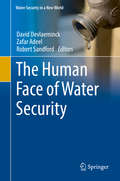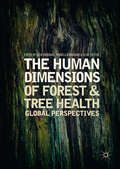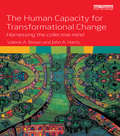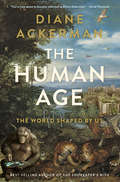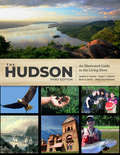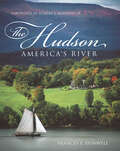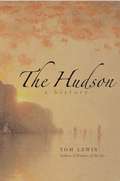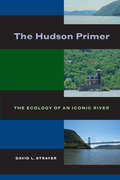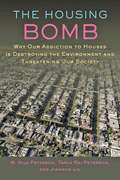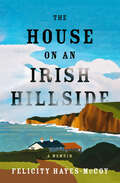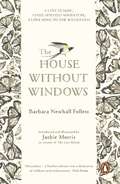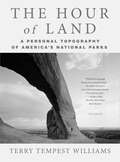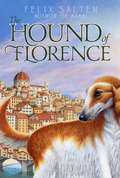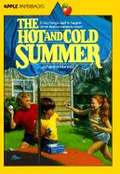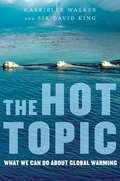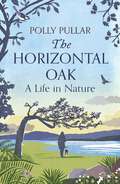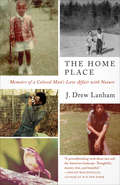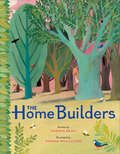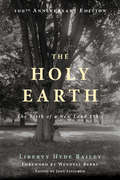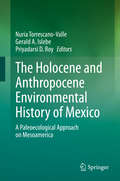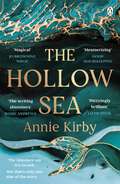- Table View
- List View
The Human Impact of Climate Uncertainty: Weather Information, Economic Planning, and Business Management
by W. J. MaunderOriginally published in 1989, this book provides an overview of the economic dimensions of climate and human activities, and considers how the variable nature of the atmosphere must be accepted as an integral part of the management package. It discusses how climatic repercussions can hold major importance for international politics, particularly in the light of the impacts of climatic changes induced by greenhouse gases.
The Human Face of Water Security
by Zafar Adeel David Devlaeminck Robert SandfordThis volume collects essays from academics and practitioners from a diversity of areas and perspectives in order to discuss water security at various levels and to illuminate the central idea of water security: its focus on the individual. Beginning with the big picture, this book aims to illustrate the depth of the water security crisis and its interconnections with other aspects of societal development. It particularly draws a connection to the 2030 Agenda for Sustainable Development, and discusses that challenges faced in meeting the 17 sustainability development goals (SDG) by the year 2030. Moving from international to domestic and community perspectives, this book provides a unique analysis of issues and solutions to the water issues we face today in light of the ever looming global changes brought on by climate change. Over the past few decades the recognition of our common need for water has increased, as policymakers have sought to place more focus on the individual within policy. After the recognition of water and sanitation as a fundamental human right by the United Nations General Assembly in 2010, there is increasing recognition of the individual as the building block for the struggle for water security. This reality also intersects with adverse impacts of global climate change, and the book responds to the broader question: will clean and safe water be available where we need it and when we need it in the future?
The Human Dimensions of Forest and Tree Health: Global Perspectives
by Clive Potter Julie Urquhart Mariella MarzanoThis book explores the specifically human dimensions of the problem posed by a new generation of invasive pests and pathogens to tree health worldwide. The growth in global trade and transportation in recent decades, along with climate change, is allowing invasive pests and pathogens to establish in new environments, with profound consequences for the ecosystem services provided by trees and forests, and impacts on human wellbeing. The central theme of the book is to consider the role that social science can play in better understanding the social, economic and environmental impacts of such tree disease and pest outbreaks. Contributions include explorations of how pest outbreaks are socially constructed, drawing on the historical, cultural, social and situated contexts of outbreaks; the governance and economics of tree health for informing policy and decision-making; stakeholder engagement and communication tools; along with more philosophical approaches that draw on environmental ethics to consider ‘non-human’ perspectives. Taken together the book makes theoretical, methodological and applied contributions to our understanding of this important subject area and encourages researchers from across the social sciences and humanities to bring their own disciplinary perspectives and expertise to address the complexity that is the human dimensions of forest and tree health.Chapters 5 and 11 are open access under a CC BY 4.0 license via link.springer.com.
The Human Capacity for Transformational Change: Harnessing the collective mind
by Valerie A. Brown John A. HarrisPressures for transformational change have become a regular feature of most fields of human endeavour. Master-thinkers and visionaries alike have reframed existing divisions as connecting relationships, bringing together as dynamic systems the supposed opposites of parts and wholes, stability and change, individuals and society, and rational and creative thinking. This reframing of opposites as interconnected wholes has led to realisation of the power of a collective mind.This book offers ways and means of creating the synergies that are crucial in influencing a desired transformational change towards a just and sustainable future. It describes how and why our current decision-making on any complex issue is marked by clashes between the different interests involved. More optimistically, the book pursues a mode of thinking that brings together government, specialised and community interests at the local, regional and personal scales in a collective transformation process. Practical examples signal the emergence of a new knowledge tradition that promises to be as powerful as the scientific enlightenment. Written in accessible language, this book will be insightful reading for anyone struggling with transformational change, especially researchers, students and professionals in the fields of administration, governance, environmental management, international development, politics, public health, public law, sociology, and community development
The Human Age: The World Shaped By Us
by Diane AckermanAs Diane Ackerman writes in her brilliant new book, The Human Age, "our relationship with nature has changed...radically, irreversibly, but by no means all for the bad. Our new epoch is laced with invention. Our mistakes are legion, but our talent is immeasurable." Ackerman is justly celebrated for her unique insight into the natural world and our place in it. In this landmark book, she confronts the unprecedented reality that one prodigiously intelligent and meddlesome creature, Homo sapiens, is now the dominant force shaping the future of planet Earth. Humans have "subdued 75 percent of the land surface, concocted a wizardry of industrial and medical marvels, strung lights all across the darkness." We tinker with nature at every opportunity; we garden the planet with our preferred species of plants and animals, many of them invasive; and we have even altered the climate, threatening our own extinction. Yet we reckon with our own destructive capabilities in extraordinary acts of hope-filled creativity: we collect the DNA of vanishing species in a "frozen ark," equip orangutans with iPads, and create wearable technologies and synthetic species that might one day outsmart us. With her distinctive gift for making scientific discovery intelligible to the layperson, Ackerman takes us on an exhilarating journey through our new reality, introducing us to many of the people and ideas now creating--perhaps saving--our future and that of our fellow creatures. A beguiling, optimistic engagement with the changes affecting every part of our lives, The Human Age is a wise and beautiful book that will astound, delight, and inform intelligent life for a long time to come.
The Hudson: An Illustrated Guide to the Living River
by Stephen P. Stanne Roger G. Panetta Brian E. Forist Maija Liisa NiemistoSince 1996, The Hudson: An Illustrated Guide to the Living River has been an essential resource for understanding the full sweep of the great river's natural history and human heritage. This updated third edition includes the latest information about the ongoing fight against pollution and environmental damage to the river, plus vibrant new full-color illustrations showing the plants and wildlife that make this ecosystem so special. This volume gives a detailed account of the Hudson River’s history, including the geological forces that created it, the various peoples who have lived on its banks, and the great works of art it has inspired. It also showcases the many species making a home on this waterway, including the Atlantic sturgeon, the bald eagle, the invasive zebra mussel, and the herons of New York Harbor. Combining both scientific and historical perspectives, this book demonstrates why the Hudson and its valley have been so central to the environmental movement. As it charts the progress made towards restoring the river ecosystem and the effects of emerging threats like climate change, The Hudson identifies concrete ways that readers can help. To that end, royalties from the sale of this book will go to the non-profit environmental advocacy group Hudson River Sloop Clearwater, Inc.
The Hudson: America's River
by Frances DunwellFrances F. Dunwell presents a rich portrait of the Hudson and of the visionary people whose deep relationship with the river inspires changes in American history and culture. Lavishly illustrated with color plates of Hudson River School paintings, period engravings, and glass plate photography, The Hudson captures the spirit of the river through the eyes of its many admirers. It shows the crucial role of the Hudson in the shaping of Manhattan, the rise of the Empire State, and the trajectory of world trade and global politics, as well as the river's influence on art and architecture, engineering, and conservation.
The Hudson: America's River
by Frances F. Dunwell&“A commanding and inspiring biography of a river that gave rise to an art movement, progressive social quests, [and] landmark environmental cases.&” —Booklist (starred review) Includes maps, photos, and illustrations Frances F. Dunwell presents a rich portrait of the Hudson and of the visionary people whose deep relationship with the river inspired changes in American history and culture. Lavishly illustrated with color plates of Hudson River School paintings, period engravings, and glass plate photography, The Hudson captures the spirit of the river through the eyes of its many admirers. It reveals the crucial role of the Hudson in the shaping of Manhattan, the rise of the Empire State, and the trajectory of world trade and global politics, as well as the river&’s influence on art and architecture, engineering, and conservation. &“A story of interaction between people and the environment and a story of continuing inspiration and renewal.&” —Library Journal
The Hudson: A History
by Tom LewisThe Hudson River has always played a vital role in American culture. Flowing through a valley of sublime scenery, the great river uniquely connects America's past with its present and future. This book traces the course of the river through four centuries, recounting the stories of explorers and traders, artists and writers, entrepreneurs and industrialists, ecologists and preservationists-those who have been shaped by the river as well as those who have helped shape it. Their compelling narratives attest to the Hudson River's distinctive place in American history and the American imagination. Among those who have figured in the history of the Hudson are Benedict Arnold, Alexander Hamilton, Franklin and Eleanor Roosevelt, the Astors and the Vanderbilts, and Thomas Cole of the Hudson River school. Their stories appear here, alongside those of such less famous individuals as the surveyor who found the source of the Hudson and the engineer who tried to build a hydroelectric plant at Storm King Mountain. Inviting us to view the river from a wider perspective than ever before, this entertaining and enlightening book is worthy of its grand subject.
The Hudson Primer: The Ecology of an Iconic River
by David L. StrayerThis succinct book gives an intimate view of the day-to-day functioning of a remarkable river that has figured prominently in history and culture--the Hudson, a main artery connecting New York, America, and the world. Writing for a wide audience, David Strayer distills the large body of scientific information about the river into a non-technical overview of its ecology. Strayer describes the geography and geology of the Hudson and its basin, the properties of water and its movements in the river, water chemistry, and the river's plants and animals. He then takes a more detailed look at the Hudson's ecosystems and each of its major habitats. Strayer also discusses important management challenges facing the river today, including pollution, habitat destruction, overfishing, invasive species, and ecological restoration.
The Housing Bomb: Why Our Addiction to Houses Is Destroying the Environment and Threatening Our Society
by Jianguo Liu M. Nils Peterson Tarla PetersonHow our thirst for more and larger houses is undermining society and what we can do about it.Have we built our way to ruin? Is your desire for that beach house or cabin in the woods part of the environmental crisis? Do you really need a bigger home? Why don’t multiple generations still live under one roof? In The Housing Bomb, leading environmental researchers M. Nils Peterson, Tarla Rai Peterson, and Jianguo Liu sound the alarm, explaining how and why our growing addiction to houses has taken the humble American dream and twisted it into an environmental and societal nightmare. Without realizing how much a contemporary home already contributes to environmental destruction, most of us want bigger and bigger houses and dream of the day when we own not just one dwelling but at least the two our neighbor does. We push our children to "get out on their own" long before they need to, creating a second household where previously one existed. We pave and build, demolishing habitat needed by threatened and endangered species, adding to the mounting burden of global climate change, and sucking away resources much better applied to pressing societal needs. "Reduce, reuse, recycle" is seldom evoked in the housing world, where economists predict financial disasters when "new housing starts" decline and the idea of renovating inner city residences is regarded as merely a good cause. Presenting irrefutable evidence, this book cries out for America and the world to intervene by making simple changes in our household energy and water usage and by supporting municipal, state, national, and international policies to counter this devastation and overuse of resources. It offers a way out of the mess we are creating and envisions a future where we all live comfortable, nondestructive lives. The "housing bomb" is ticking, and our choice is clear—change our approach or feel the blast.
The House on an Irish Hillside: A Memoir
by Felicity Hayes-McCoy&“A lovely writer, far superior to the average memoirist. . . . A curious mind, a perceptive observer with an artist&’s eye, a seeker of truth and beauty.&” —Irish IndependentFrom the moment I crossed the mountain, I fell in love with the place, which was more beautiful than any I&’d ever seen. And with a way of looking at life that was deeper, richer and wiser than any I&’d known before. . . . From the first day I came here I always knew I&’d come back. Sometimes we have to go back to our beginnings to become the person we want to be. More than a decade ago, USA Today–bestselling author Felicity Hayes-McCoy left the hectic pace of London and returned to her home country of Ireland to forge a new life in a remarkable house on the stunning Dingle peninsula. Gorgeously written, this is a life-affirming tale of rediscovering lost values and remembering the things that matter most. &“Wise, funny and touching, this book is a portrait of friendships, customs and folklore of Ireland; but what stays with you is harder to catch, like smoke or running water. It is the taste of something we all once knew, ever-present if only you look for it.&” ―Joanna Lumley, actress and author of Absolutely: A Memoir &“The book glowed . . . when I finished reading, I felt a sense of well-being, wonder and delight.&” —Alice Taylor, bestselling author of To School Through the FieldsPraise for Felicity Hayes-McCoy &“A pitch-perfect delight.&” —Marian Keyes, international bestselling author of Grown Ups on The Transatlantic Book Club &“The spot-on descriptions of Ireland&’s country roads and expansive sky all but leap off the page. . . . Maeve Binchy and Patrick Taylor fans will find much to enjoy.&” —Booklist on The Library at the Edge of the World &“Sunshine on the page.&” —Cathy Kelly, bestselling author of Between Sisters on The Month of Borrowed Dreams
The House Without Windows
by Barbara Newhall FollettEscape into the wild from the comfort of your own home this winter, with a dazzling lost classic of nature writing... Eepersip is a girl with the wild in her heart. She does not want to live locked up behind the walls of a house. So she runs away - first to the Meadow, then to the Sea, and finally to the Mountain. Her heartbroken parents follow their daughter, trying to bring her home safe, but Eepersip has other ideas...Republished by Penguin with a new introduction and hand-inked illustrations by beloved artist Jackie Morris, The House Without Windows is a timeless fable about wildness, freedom and the redemptive power of the natural world.'I can safely promise joy to any reader of The House Without Windows. Perfection' Eleanor Farjeon, winner of the Carnegie Medal and The Hans Christian Andersen Award 'Gloriously illuminated by Jackie Morris's moving art, this is a work of strange power for our own bewildered times' Nick Drake 'A classic, as miraculous and awe-inspiring as the author' Xinran, author of The Good Women of China
The Hour Of Land: A Personal Topography Of America's National Parks
by Terry Tempest WilliamsAmerica’s national parks are breathing spaces in a world in which such spaces are steadily disappearing, which is why more than 300 million people visit the parks each year. Now Terry Tempest Williams, the New York Times bestselling author of the environmental classic Refuge and the beloved memoir When Women Were Birds, returns with The Hour of Land, a literary celebration of our national parks and an exploration of what they mean to us and what we mean to them. From the Grand Tetons in Wyoming to Acadia in Maine to Big Bend in Texas, Williams creates a series of lyrical portraits that illuminate the unique grandeur of each place while delving into what it means to shape a landscape with its own evolutionary history into something of our own making. Part memoir, part natural history, and part social critique, The Hour of Land is a meditation and a manifesto on why wild lands matter to the soul of America.
The Hound of Florence
by Felix Salten Huntley PatersonIt's a dog's life for a boy when he magically turns into a hound in this classic story from the author of Bambi.On a routine walk through the streets of his hometown of Vienna, Lucas Grassi sees an archduke's coach. He can't help but wish he was rich and powerful and leaving the dark city behind. And when he sees the archduke's faithful dog running alongside, he wishes he could just be the dog and be free from his everyday life. And then his wish comes true: Lucas does become the dog. Every other day he switches from his normal body to that of the archduke's canine companion. Soon he learns the dog is treated badly and the archduke is not a nice man. Lucas decides he'll do anything to reverse his wish...if only he knew what to do! Felix Salten's tale of a wish gone awry is brought back to life in this beautiful repackage.
The Hot and Cold Summer
by Johanna HurwitzRory and Derek were best friends but with Bolivia visiting next door, would their friendship last?
The Hot Topic: What We Can Do About Global Warming
by Gabrielle Walker David KingA book that explains the science behind global warming, the most cutting-edge technological solutions from small to large, and the national and international politics that will affect our efforts
The Horizontal Oak: A Life in Nature
by Polly PullarPeppered with humour, empathy and kindness' - Sunday Post Ever since her pet sheep Lulu accompanied her to school at the age of seven, animals and nature have been at the heart of Polly Pullar’s world. Growing up in a remote corner of the Scottish West Highlands, she roamed freely through the spectacular countryside and met her first otters, seals, eagles and wildcats. But an otherwise idyllic childhood was marred by family secrets which ultimately turned to tragedy. Following the suicide of her alcoholic father and the deterioration of her relationship with her mother, as well as the break-up of her own marriage, Polly rebuilt her life, earning a reputation as a wildlife expert and rehabilitator, journalist and photographer. This is her extraordinary, inspirational story. Written with compassion, humour and optimism, Polly reflects on how her love of the natural world has helped her find the strength to forgive and understand her parents, and to find an equilibrium.
The Homevoter Hypothesis: How Home Values Influence Local Government Taxation, School Finance, and Land-Use Policies
by William A. FischelJust as investors want the companies they hold equity in to do well, homeowners have a financial interest in the success of their communities. If neighborhood schools are good, if property taxes and crime rates are low, then the value of the homeowner’s principal asset—his home—will rise. Thus, as William Fischel shows, homeowners become watchful citizens of local government, not merely to improve their quality of life, but also to counteract the risk to their largest asset, a risk that cannot be diversified. Meanwhile, their vigilance promotes a municipal governance that provides services more efficiently than do the state or national government. Fischel has coined the portmanteau word “homevoter” to crystallize the connection between homeownership and political involvement. The link neatly explains several vexing puzzles, such as why displacement of local taxation by state funds reduces school quality and why local governments are more likely to be efficient providers of environmental amenities. The Homevoter Hypothesis thereby makes a strong case for decentralization of the fiscal and regulatory functions of government.
The Home Place: Memoirs of a Colored Man's Love Affair with Nature
by J. Drew Lanham&“A groundbreaking work about race and the American landscape, and a deep meditation on nature…wise and beautiful.&”—Helen Macdonald, author of H is for Hawk A Foreword Reviews Best Book of the Year and Nautilus Silver Award Winner In me, there is the red of miry clay, the brown of spring floods, the gold of ripening tobacco. All of these hues are me; I am, in the deepest sense, colored. Dating back to slavery, Edgefield County, South Carolina—a place &“easy to pass by on the way somewhere else&”—has been home to generations of Lanhams. In The Home Place, readers meet these extraordinary people, including Drew himself, who over the course of the 1970s falls in love with the natural world around him. As his passion takes flight, however, he begins to ask what it means to be &“the rare bird, the oddity.&” By turns angry, funny, elegiac, and heartbreaking, The Home Place is a meditation on nature and belonging by an ornithologist and professor of ecology, at once a deeply moving memoir and riveting exploration of the contradictions of black identity in the rural South—and in America today. &“When you&’re done with The Home Place, it won&’t be done with you. Its wonders will linger like everything luminous.&”—Star Tribune &“A lyrical story about the power of the wild…synthesizes his own family history, geography, nature, and race into a compelling argument for conservation and resilience.&”—National Geographic
The Home Builders
by Varsha BajajThis vibrantly illustrated picture book celebrates a variety of woodland creatures as they make their homes and prepare for their young.Welcome to a serene woodland where lots of expectant animal parents are in their "nesting" phase--that is, busy preparing safe, cozy homes for their growing families. As they dig, tunnel, gnaw, and gather, they create dens, burrows, lodges, and, of course, nests. Soon the woods are full of new little ones peeping, crawling, romping, and snuggling--and with artwork so gorgeous that it feels like an invitation into the scenery it's depicting, readers will be eager to join them in their beautiful home.
The Holy Earth: The Birth of a New Land Ethic
by Wendell Berry Liberty Hyde Bailey John LinstromThe agrarian tradition runs as an undercurrent through the entire history of literature, carrying the age-old wisdom that the necessary access of independent farmers to their own land both requires the responsibility of good stewardship and provides the foundation for a thriving civilization. At the turn of the last century, when farming first began to face the most rapid and extensive series of changes that industrialization would bring, the most compelling and humane voice representing the agrarian tradition came from the botanist, farmer, philosopher, and public intellectual Liberty Hyde Bailey. In 1915, Bailey's environmental manifesto, The Holy Earth, addressed the industrialization of society by utilizing the full range of human vocabulary to assert that the earth's processes and products, because they form the governing conditions of human life, should therefore be understood not first as economic, but as divine. To grasp the extent of human responsibility for the earth, Bailey called for "a new hold" that society must take to develop a "morals of land management," which would later inspire Aldo Leopold's "land ethic" and several generations of agrarian voices. This message of responsible land stewardship has never been as timely as now.
The Holocene and Anthropocene Environmental History of Mexico: A Paleoecological Approach on Mesoamerica
by Nuria Torrescano-Valle Gerald A. Islebe Priyadarsi D. RoyThis book provides essential information on Mexico’s Holocene and Anthropocene climate and vegetation history. Considering the geography of Mexico – which is home to a variety of climatic and environmental conditions, from desert and tropical to high mountain climates – this book focuses on its postglacial paleoecology and paleoclimatology. Further, it analyses human intervention since the middle Holocene as a major agent of environmental change. Offering a valuable tool for understanding past climate change and its relationship with present climate change, the book is a must-read for botanists, ecologists, palaeontologists and graduate students in related fields.
The Hollow Sea: The unforgettable and mesmerising debut inspired by mythology
by Annie KirbyTHE ISLANDERS SAY IT'S CURSED. BUT THAT'S ONLY ONE SIDE OF THE STORY . . .'A bold, magical story' JO BROWNING WROE, Sunday Times bestselling author of A Terrible Kindness'A majestic work of the imagination . . . I woke up thinking about it' ROSIE ANDREWS, Sunday Times bestselling author of The Leviathan'An atmospheric tale, shot through with folklore. The writing shimmers' KATE SAWYER, Costa shortlisted author of The Stranding_______They say the Hollow Sea is cursed. A wild expanse separating the remote islands of St Hía, not even the locals brave its treacherous waters.But new arrival Scottie feels a pull she can't ignore. Because behind the curse is the legend of Thordis: a woman whose story feels eerily familiar. No one knows what became of her, but Scottie believes Thordis's fate may answer questions about her own past.Despite the islanders' warnings, Scottie sets out to discover the truth. But as she dares to cross the Hollow Sea, will its secrets give her the answers she needs?Or will the past drag her under?_______'A heart-rending atmospheric novel of finding what makes one whole' Melissa Fu, author of Peach Blossom Spring'Mesmerising' Good Housekeeping'A poetic tale' Prima
The Hole in the Tree
by Jean Craighead GeorgeWho will be the king of the hole in the tree? A delightful book where two children find a hole in a tree and watch as it becomes larger through the occupation of successive animals. Starting with a small beetle who begins the hole and the progression to different insects, birds and other animals. Even the two children use the hole once he gets large enough through the progression.

